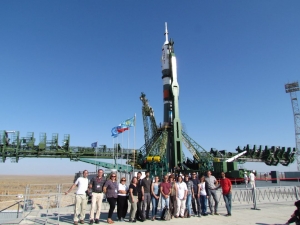Mini-EUSO is flying to space: the Earth as a huge detector
22-08-2019
On August 22, 2019, at 5:38:33 (CEST), the Soyuz 2.1 rocket carrying the Soyuz MS-14 module launched towards the International Space Station (ISS) from the Baikonur Cosmodrome in Kazakhstan. Among the loads there is the Mini-EUSO telescope. The device makes it possible to create an ultraviolet map of the Earth’s atmosphere and allows to observe its variability in time. The project, which is attended by Polish scientists from the National Centre for Nuclear Research, is the preliminary stage of the JEM-EUSO project to air showers of particles and photons.
Air showers are cascades of particles and photons formed as a result of the interaction of high-energy cosmic particles (with energy in the order of 1011 GeV and greater) with the Earth’s atmosphere. Their research is carried out by the JEM-EUSO (Joint Experiment Missions – Extreme Universe Space Observatory) program. An international team of scientists wishes to create a new type of observatory based on a very large UV telescope in orbit around the Earth, for which the entire Earth will be a detector. The telescope is to observe traces of fluorescence caused by atmospheric showers. The Mini-EUSO (Multiwavelength Imaging New Instrument for the Extreme Universe Space Observatory) mission is part of the JEM-EUSO program. „The detector sent today to the International Space Station will allow for the creation of an ultraviolet map of the Earth’s atmosphere,” says Jacek Szabelski, PhD, from the NCBJ Astrophysics Division, who participates in the program. „We want to study precisely how the atmosphere’s ultraviolet radiation changes over time. The purpose of Mini-EUSO is to observe fluorescence caused by various atmospheric phenomena: TLE (Transient Luminous Events), fluorescence caused by the passage of meteorites and meteoroids through the atmosphere, as well as traces of space debris burning up in the atmosphere. In addition, the experiment will make it possible to search for quarks of strange matter – SQM (Strange Quark Matter). „
The JEM-EUSO is a multi-stage project. The data collected by the Mini-EUSO detector will be a valuable information before the key stages of the research, when the target detectors will be placed on one of the ISS modules. Earlier, three stages of the project were completed: the EUSO-TA on-ground fluorescence detector was installed in 2013 at Black Rock Mesa in Utah, USA; later EUSO-Ballon, a stratospheric balloon equipped with a detection module, took a 5-hour flight, and in 2017 EUSO-SPB (Super Pressure Balloon) performed measurements for 12 days. „One of the goals of Mini-EUSO is to more accurately determine the background and conditions of measurement and to clarify the settings of the apparatus in the target experiment” – explains Marika Przybylak, MSc, from the NCBJ Astrophysics Division.
The Mini-EUSO’s journey to the International Space Station will take about two days. The apparatus will be placed in a special, UV-transparent window on the Russian module of the station. „The window will be directed parallel to the Earth’s surface throughout the entire passage of the station, so that it will be possible to register ultraviolet radiation emitted from the atmosphere above the surface of the globe” – describes Szabelski, PhD. „The device consists of a telescope with a large field of view (± 21 degrees), based on an optical system utilising two Fresnel lenses to increase the field from which data is collected. UV rays are registered with a detector consisting of a photomultiplier matrix (size 48x48 pixels). Mini-EUSO will be able to record 400,000 frames per second, thanks to which it will be possible to observe the dynamics of changes in the level of radiation. The device is currently one of the fastest systems monitoring the fluorescence of the atmosphere. The collected data will be sent on storage media during transport flights from the station to Earth, because such a large amount of data could overload the ISS data transmission system.”
306 scientists from 16 countries participate in the JEM-EUSO project. NCBJ is represented by six scientists from the Cosmic Ray Laboratory of the Astrophysics Department, Łódź. „We have constructed a high-voltage power supply that works with each of the system components” – informs Szabelski, PhD. „It was not an easy task, because the whole device must respond to changes in radiation intensity, which it registers” – added Przybylak, MSc. „Our system protects the detector against overload and allows for stable research.”





